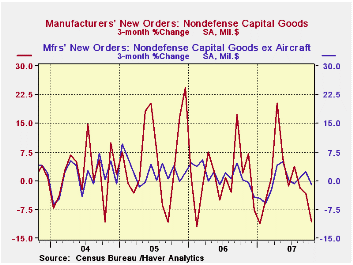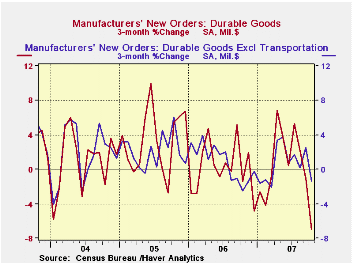 Global| Nov 28 2007
Global| Nov 28 2007U.S. Durable Goods Orders Down Big for Second Month
by:Tom Moeller
|in:Economy in Brief
Summary
Orders for durable manufactured goods fell for the third consecutive month. The 0.4% slip in October followed a 1.4% slide in September that was only slightly revised. The latest slip contrasted with Consensus expectations for a 0.2% [...]

Orders for durable manufactured goods fell for the third consecutive month. The 0.4% slip in October followed a 1.4% slide in September that was only slightly revised. The latest slip contrasted with Consensus expectations for a 0.2% uptick.
Excluding the notably volatile transportation sector, orders fell an unexpected 0.7% although the September figure was revised to a 1.1% gain from the slight 0.3% increase reported initially.
In the transportation sector, orders for aircraft & parts fell 6.3% (+9.9% y/y) owing to a 5.2% (+10.6% y/y) decline in nondefense orders. Orders for motor vehicles & parts also fell a hefty 1.4% (-3.7 y/y), down big for the third consecutive month.
Orders for nondefense capital goods slid 3.1% helped lower by the drop in aircraft. Less aircraft, however, orders were also weak and posted a 2.3% decline. Three month growth in these orders fell to -1.0%, the weakest since early this year.
Fewer orders for communications equipment led the decline with a 22.6% (+3.3% y/y) plunge. Machinery orders also fell 1.7% and three month growth in these orders fell to -1.7%. 
Also down were orders for computers & related products which fell 15.2% (+11.9% y/y) after strong gains during the prior two months.
To the upside, primary metal orders rose 3.0% (5.0% y/y) but over the last three months the gain is a weaker 0.5%.Orders for electrical equipment, appliances and components recovered all of the prior month's decline with a 4.1% (1.8% y/y) gain.
Overall shipments of durable goods rose 0.6% (1.4% y/y) after large declines during the prior two months. Less transportation shipments rose 0.6% (1.6% y/y) after two months of declines by a like amount.
Inventories of durable goods rose 0.2% (2.1% y/y) and less transportation rose 0.2% as well (1.2% y/y).
Unfilled orders were firm again last month and rose 1.0% (17.9% y/y). Much of that strength has been due, however, to the strength in orders for aircraft. Less the transportation sector altogether unfilled orders rose 0.7% in October and the y/y gain is a lesser 9.3%.
Financial Markets and Central Banking, today's speech by Federal Reserve Board Vice ChairmanDonald L. Kohn at the Council on Foreign Relations, New York, New York, is available here.
Minutes of Board discount rate meetings, October 1 through October 31, 2007 from the Federal Reserve Board can be found here.
| NAICS Classification | October | September | Y/Y | 2006 | 2005 | 2004 |
|---|---|---|---|---|---|---|
| Durable Goods Orders | -0.4% | -1.4% | 1.9% | 6.3% | 9.9% | 5.3% |
| Excluding Transportation | -0.7% | 1.1% | 2.0% | 7.6% | 8.8% | 7.9% |
| Nondefense Capital Goods | -3.1% | 4.8% | -0.8% | 10.6% | 17.1% | 5.7% |
| Excluding Aircraft | -2.3% | 1.2% | -2.4% | 8.5% | 11.1% | 3.2% |
Tom Moeller
AuthorMore in Author Profile »Prior to joining Haver Analytics in 2000, Mr. Moeller worked as the Economist at Chancellor Capital Management from 1985 to 1999. There, he developed comprehensive economic forecasts and interpreted economic data for equity and fixed income portfolio managers. Also at Chancellor, Mr. Moeller worked as an equity analyst and was responsible for researching and rating companies in the economically sensitive automobile and housing industries for investment in Chancellor’s equity portfolio. Prior to joining Chancellor, Mr. Moeller was an Economist at Citibank from 1979 to 1984. He also analyzed pricing behavior in the metals industry for the Council on Wage and Price Stability in Washington, D.C. In 1999, Mr. Moeller received the award for most accurate forecast from the Forecasters' Club of New York. From 1990 to 1992 he was President of the New York Association for Business Economists. Mr. Moeller earned an M.B.A. in Finance from Fordham University, where he graduated in 1987. He holds a Bachelor of Arts in Economics from George Washington University.






